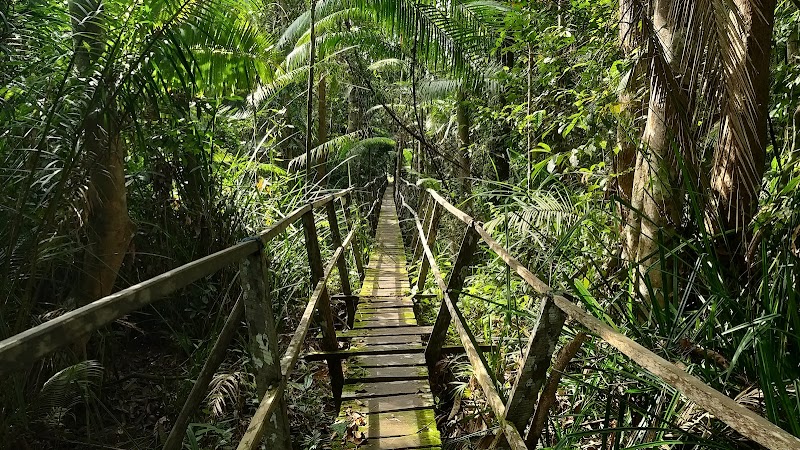Tracking Orangutans in the Heart of Borneo: A Guide to Samboja Lestari
Witness the compelling journey of orangutan rehabilitation in Borneo’s Samboja Lestari. This accessible forest trek offers a close encounter with these remarkable primates while immersing you in the rhythms of one of the world's richest rainforests.
Start Early for Best Wildlife Sightings
Orangutans are most active in the early morning before the forest warms, so plan to begin your hike by 7 AM to maximize viewing opportunities.
Wear Waterproof Footwear
The trail can be muddy and slippery, especially after rain. Reliable boots with good grip prevent slips and protect your feet from roots and insect bites.
Carry At Least 2 Liters of Water
The humid tropical climate accelerates dehydration; staying hydrated keeps energy up and focus sharp during your trek.
Use Silent Movement and Soft Voices
Minimize noise to avoid startling orangutans; slow, quiet steps and whispering encourage natural behaviors and richer wildlife experiences.
Tracking Orangutans in the Heart of Borneo: A Guide to Samboja Lestari
Samboja Lestari, located near Balikpapan in East Kalimantan, Indonesia, offers a unique opportunity to observe orangutans in a semi-wild environment dedicated to their rehabilitation. The trek through the rainforest here is a measured adventure—about 3 kilometers of gently rolling terrain with an elevation gain of roughly 150 meters. The forest floor hums quietly beneath your feet, the leaves above shifting with a thousand subtle movements, as curious orangutans swing with deliberate grace in the canopy.
The trail, shaded and often damp from tropical humidity, invites you to move thoughtfully, respecting the fierce independence of this forest ecosystem. The vegetation, thick and bustling with life, seems to watch and listen as you pass. Expect mud patches after occasional rain, roots that grip the soil at odd angles, and the steady soundtrack of birds and insects claiming the space.
Your best chance to see the orangutans is at feeding stations scattered along the path, where these majestic apes often visit to supplement their diet. They approach on their own terms—there’s no rush here, only patience and quiet observation. Planning your visit for early morning increases the likelihood of sightings, as these animals are most active before midday heat sets in.
Hydration is critical: the tropical air pulls moisture quickly. Carry at least 2 liters of water per person and wear sturdy, waterproof boots with good tread to handle slippery ground. A light, breathable long-sleeve shirt will keep insects at bay while protecting from sun and scratches. A compact binocular can sharpen distant views, but be prepared to let your eyes adjust to the forest’s forgiving dimness.
Beyond orangutans, the forest offers curious gibbons calling in the distance and the occasional glimpse of hornbills soaring above. Guides at Samboja Lestari offer invaluable insights into the rehabilitation efforts, risks that orangutans face from habitat loss, and the delicate balance required to maintain this sanctuary.
Respectful engagement here is essential: speak softly, move deliberately, and allow the forest its wildness. This is an adventure in coexistence—a chance to witness a species fiercely itself, amid the rain-soaked folds of one of Earth’s most vital jungles.
Nearby Trips
All Adventures
Boat Charters
Water Activities
Adventures near Balikpapan
Discover the unique and memorable adventures that make Balikpapan special.
Frequently Asked Questions
How close can I get to the orangutans at Samboja Lestari?
Visitors typically observe orangutans from designated feeding platforms and trails, maintaining a respectful distance of several meters to avoid disturbing them. Direct contact is not permitted, ensuring the animals remain comfortable and safe.
Is a guide required to visit Samboja Lestari?
Yes. A trained local guide accompanies all visitors, providing insights on the orangutans, safety instructions, and the best routes to spot wildlife.
What is the best time of day to visit for wildlife viewing?
Early mornings, around 7 to 10 AM, are ideal when orangutans and other wildlife are most active before midday heat.
Are there any health precautions travelers should take before visiting?
Vaccinations for tetanus and typhoid are advisable. Using insect repellent and wearing appropriate clothing helps protect from mosquitoes and other insects.
Can families with children participate in the trek?
Yes, the relatively short and moderate trail can be suitable for families with children aged seven and above, provided they are comfortable with uneven terrain and tropical conditions.
How does the Samboja Lestari Foundation contribute to conservation?
The foundation focuses on rescuing and rehabilitating orphaned orangutans, restoring degraded rainforest habitat, and educating the public about conservation challenges facing Borneo’s wildlife.
Recommended Gear
Waterproof Hiking Boots
Protects feet on muddy, uneven terrain while maintaining grip and support throughout the hike.
Lightweight Long-Sleeve Shirt
Offers sun protection and insect defense without overheating in humid tropical conditions.
Reusable Water Bottle (2L minimum)
Essential for staying hydrated in the hot and humid environment.
Compact Binoculars
Enhances the viewing experience by bringing distant orangutans and canopy life into sharper focus.
Local Insights
Hidden Gems
- "A small waterfall less than a kilometer from the main trail offers a quiet spot for reflection away from the feeding stations."
- "A viewpoint along a ridge offers sweeping vistas of restored forest and distant hills, perfect for a midday break."
Wildlife
- "Look for the agile gibbons whose calls echo through the canopy, along with various hornbill species that patrol the skies."
- "The forest floor sometimes reveals slow-moving pangolins or the scattered tracks of civets."
History
"Samboja Lestari was founded in the early 2000s as a response to widespread habitat loss. It stands as a living example of how active reforestation paired with wildlife rehabilitation can foster recovery."

